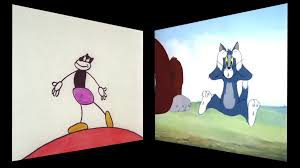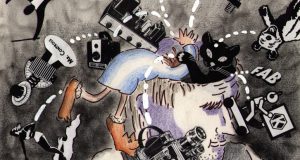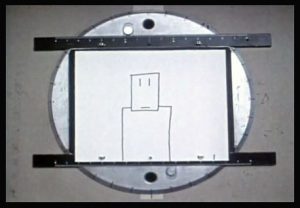
When it comes to experimental cinema, I am particularly attracted to animation. Animation can be seen as the foundation on which cinema is based, and by it’s very nature allows for a reconstruction of cinema itself. If cinema or video reflects the world, animation exists outside of reality. There are no rules in animation, save for how well you can draw (or digitally sculpt), and how much patience you have.(The exception being stop-motion, which does require a connection to the world around you.) Much early animation involved playing around with moving drawings, creatively scratching the film stock, or discovering the magic of stop motion. It can be said then, that experimental animation is often about craft.
The program I attended at the Metrograph, Griffiti: Animation by George Griffin, reflects this focus on craft. The first short in the program, Rapid Transit, was done by arranging beans and other objects on a white, lit background in stop motion to create “kinetic, percussive” imagery in time with the background music. (The short was celebrating its 50th anniversary.) the second short, Trikfilm 3, alternated between a surreal hand-drawn animation and scenes of Griffin drawing the piece on a notepad in stop-motion. The stop-motion segments feature Griffin at a table drinking coffee when he decides to start the piece—creating art out of just a notepad and boredom.

One of the more interesting pieces was Flying Fur. The piece was set to the background music from the Tom and Jerry cartoon, Puttin’ on the Dog. Knowing nothing about the source of the music, Griffin animated what he thought would be happening based on the score, only finding out where it was from later. (The piece was shown as Puttin’ on the Fur, in which both the original cartoon and Griffin’s piece were shown side by side. Similarly, Ko-Ko was an an animation using cutouts, animated in rhythm with music by Charlie Parker. The piece was intended to be part of a larger project involving Parker that was never completed.
Midway through the program, there was a documentary by Griffin and DeeDee Halleck, Meadows Green, featuring the Bread and Puppet Theater, a politically radical puppet theater. It was, not surprisingly, an outsider among the rest of the shorts. In a Q&A afterwards, DeeDee claimed that it was difficult to find distribution for the piece on American television. The short simply shows the theater’s antics at their annual Bread and Puppet Circus, occasionally broken up by Griffin’s animation. One of the first questions brought up by executives at PBS was why there wasn’t a narrator, which I found quite telling about the television industry back then: even PBS wanted to play it safe. One short piece near the end, The Bather, stood out to me. The film features a live-action shot of Griffin’s wife bathing behind the shower door, as a drawing of the woman plays in the foreground. In lieu of titles, a description of the short, including plot, genre, and themes, scrolls across the screen, eventually giving the audience some context that would not be otherwise apparent.

The best piece by far, however, was Lineage. A half-hour in length, and combining various types of stop-motion with hand-drawn animation, the piece deconstructs the nature of animation itself in, as Griffin’s Vimeo page puts it, “an anti-cartoon essay on animation’s contradictory legacy: comedy and formalism.” In one part of the short, The character Griffin creates interacts with the version of itself from the previously-drawn frame of animation, before stealing scissors and cutting itself free. This character, in stop-motion, is itself shown using a hand-cranked device to create an animation with moving lines. One section of the piece involves Griffin drawing on photocopied film stock, which moves in stop-motion as he colors it in. As this scene plays, he laments that the capture of images has gone from an art to a means of profit.
I found these pieces interesting and amusing, often in equal measure. All of them and more can be found at
https://vimeo.com/geogrif.